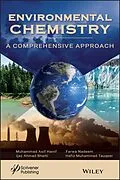The most comprehensive and up-to-date volume on environmental chemistry available today, this is the standard reference for any chemical or environmental engineer.
This book is a very comprehensive project designed to provide complete information about environmental chemistry, including air, water, soil and all life forms on earth. The complete chemical composition and all the essential components of the atmosphere, hydrosphere, geosphere, lithosphere and biosphere are discussed in detail. Numerous forms of pollutants and their toxic effects along with sustainable solutions are provided.
Not just covering the basics of environmental chemistry, the authors discuss many specific areas and issues, and they provide practical solutions. The problems of non-renewable energy processes and the merits of renewable energy processes along with future fuels are discussed in detail, making this volume a comprehensive collaboration of many other relevant fields which tries to fill the knowledge gap of all previously available books on the market. It also thoroughly covers all environment-related issues, internationally recognized standard values, and the socioeconomic impacts on society for the short and long term.
A valuable reference for engineers, scientists, chemists, and students, this volume is applicable to many different fields, across many different industries, at all levels. It is a must-have for any library.
Autorentext
Muhammad Asif Hanif is a well-known scientist and currently working on different aspects of environmental remediation and analysis. He has published over 120 peer-reviewed journal articles, four books, and several book chapters. He has twelve years of experience teaching graduate students at the university level, and, in 2018, he won a prestigious award from the Pakistan Academy of Sciences.
Farwa Nadeem has been working as an environmentalist for the last five years, providing protection against harmful human activities and educating the public about environmentalism. Her field of research at the Nano and Biomaterial Laboratory at the Department of Chemistry, University of Agriculture, Faisalabad, Pakistan is alternative, renewable, and sustainable future energy resources.
Ijaz Ahmad Bhatti is a well-known scientist and chemistry professor currently working on different aspects of radiation chemistry and renewable energy processes. He has published more than 126 international research papers in peer reviewed journals and approximately more than 40 papers in national journals. He has received various national and international scientific awards and has continuously been honoured with the "Research Productivity Award" seven times by the Pakistan Council of Science and Technology. He also has written several books and book chapters.
Hafiz Muhammad Tauqeer is Lecturer of Chemistry with a specialization in environmental sciences. He has more than twenty publications in environmental chemistry and sciences and has experience in many niche areas in environmental chemistry.
Inhalt
Acknowledgments xxiii
1 Introduction to Environmental Chemistry 1
1.1 Beginning of the Universe 1
1.2 Plank's Time 2
1.3 Components of Solar System 3
1.4 Electromagnetic Spectrum and Solar Radiations 5
1.4.1 Types of Electromagnetic Radiations 5
1.4.1.1 Cosmic Rays 5
1.4.1.2 Gamma Rays 6
1.4.1.3 X-Rays 6
1.4.1.4 Ultra-Violet Region 6
1.4.1.5 Visible Region 7
1.4.1.6 Infra-Red Region 7
1.4.1.7 Terahertz Region 7
1.4.1.8 Microwave Region 8
1.4.1.9 Radiowave Region 8
1.5 Evolution of Environmental Segments 8
1.5.1 Evolution of Atmosphere 8
1.5.1.1 First Stage of Atmospheric Evolution 9
1.5.1.2 Second Stage of Atmospheric Evolution 9
1.5.1.3 Third Stage of Atmospheric Evolution 9
1.5.2 Evolution of Hydrosphere 10
1.5.3 Evolution of Lithosphere/Geosphere 10
1.5.4 Evolution of Biosphere 11
1.6 Environmental Segments 11
1.7 Scope of Environmental Chemistry in Modern World 12
1.7.1 Pollution 12
1.7.2 Climate Change 12
1.7.3 Global Warming 12
1.7.4 Deforestation 13
1.7.5 Overpopulation 13
1.7.6 Industrial and Household Waste 13
1.7.7 Acid Rain 13
1.7.8 Ozone Layer Depletion 14
1.7.9 Genetic Engineering 14
1.7.10 Urban Sprawl 14
1.8 Solutions of Environmental Problems 14
1.8.1 Green Chemistry 15
1.8.2 Renewable Energy Processes 15
1.8.3 Biofuels 15
1.8.4 Role of Biotechnology 16
2 Atmosphere 17
2.1 Introduction to Atmosphere 17
2.1.1 Layers of Atmosphere 18
2.1.1.1 Troposphere 18
2.1.1.2 Stratosphere 19
2.1.1.3 Mesosphere 20
2.1.1.4 Thermosphere 20
2.1.1.5 Exosphere 21
2.1.2 Importance of Atmosphere 21
2.1.3 Components of Atmosphere 22
2.1.3.1 Primary Gases 23
2.1.3.2 Greenhouse Gases (GHGs) 23
2.1.3.3 Reactive Gases 24
2.1.3.4 Aerosols 28
2.1.3.5 Deviations with Height 28
2.1.3.6 Deviations with Latitude and Season 29
2.1.3.7 Deviations with Time 30
2.2 Solar Radiations and Energy Budget 32
2.2.1 Total Radiations of Sun 32
2.2.1.1 Solar Output 32
2.2.1.2 Distance from Sun 34
2.2.1.3 Altitude of Sun 35
2.2.1.4 Day Length 35
2.2.2 Effects of Solar Radiations 35
2.2.2.1 Transference of Energy 35
2.2.2.2 Effect of Atmosphere 36
2.2.2.3 Effect of Cloud Cover 37
2.2.2.4 Effect of Latitude 37
2.2.2.5 Effect of Land and Sea 38
2.2.2.6 Effect of Elevation 40
2.2.2.7 Temperature Variations with Height 40
2.2.3 IR Radiations and Greenhouse Effects 41
2.2.4 Earth's Heat Budget 43
2.3 Atmospheric Moisture Budget 44
2.3.1 Condensation 44
2.3.2 Precipitation 44
2.3.2.1 Forms of Precipitation 45
2.3.2.2 Characteristics of Precipitation 46
2.3.2.3 Pattern of Precipitation 46
2.4 Variability of Atmosphere 47
2.4.1 Cloud Formation 47
2.4.1.1 Condensation Nuclei 47
2.4.1.2 Types of Clouds 48
2.4.1.3 Cloud Cover 54
2.4.2 Precipitation Formation 54
2.5 Reactions in Atmosphere 55
2.5.1 Photochemical Reactions 56
2.5.2 Biochemical Reactions 61
2.5.3 Acid Base Reactions 62
2.5.4 Reactions of Oxygen 63
2.5.5 Reactions of Nitrogen 66
2.5.6 Reactions of Carbon Dioxide 68
3 Air Pollution and Control Strategies 71
3.1 Introduction to Air Pollution 71
3.1.1 Particles in Atmosphere 72
3.1.2 Inorganic Air Pollutants 73
3.1.2.1 Composition of Particles 74
...
